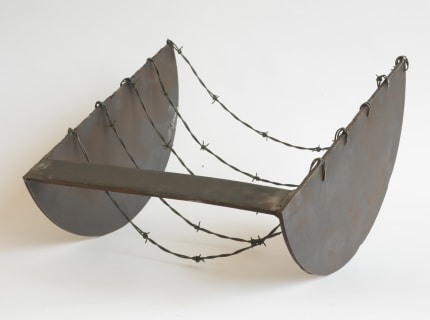When the painter Sam Gilliam died last weekend at age 88, he left behind pioneering artworks, particularly his draped canvases stained with blooms of color that forever changed the way the world would conceive of a painting. But he also left a more personal legacy: his impact on fellow artists and friends.
The sculptor Melvin Edwards, 85, was a friend of Gilliam’s for more than 50 years, forming a tight trio with the painter William T. Williams. Edwards and Gilliam owned each other’s work and interrogated each other endlessly about process, sometimes talking three or four times a day.
“We were always asking why the other had done something a certain way,” said Edwards, perhaps best known for his “Lynch Fragments” and barbed-wire series. “But that was the nature of Sam’s work: It always questioned space.”
The multimedia artist Rashid Johnson, 44, got to know Gilliam a decade ago and saw the older maker as a mentor and role model.
“I knew his work far before we met, and he had so much influence on me,” said Johnson, who has made his name with plant-filled installations and abstract, pandemic-era anxiety drawings. “He’s been informing my life since I was in my late teens.”
Just two days after Gilliam’s death, Edwards and Johnson talked about how they are processing his life and work, his decision to stay in Washington, D.C., and his success in being his own best critic, in a conversation that has been edited and condensed.
How do you look now at Sam’s signature move — taking the canvas off the wall and draping it, which he said was partly inspired by laundry hanging on clotheslines?
MELVIN EDWARDS Sam was a very fine painter who was curious and experimental. Thinking about the surfaces art was made on didn’t start with Sam — but he took a step most people didn’t understand was possible. Sam took the step. He got seen the right way by some people who were paying attention to that kind of thing, and they immediately blessed it.
Often fellow artists are pretty quick to recognize the implications of style and possible significance. One of the earliest things I did involved suspended elements of steel and chains. When Sam and I showed together at the Studio Museum in Harlem [in a landmark 1969 show], I was doing the first of the barbed wire pieces of mine, some of which were wall-attached, some of which were suspended. And we almost took it for granted that we were both taking steps.
So there were these eddies and echoes between you, right?
EDWARDS Look, it’s all a visual art, it’s not about labeling. It’s either up or down or left or right. For me and most artists, it’s like having a baby. When you’re having sex you’re not thinking about what you name the baby.
...
Read full interview at nytimes.com


